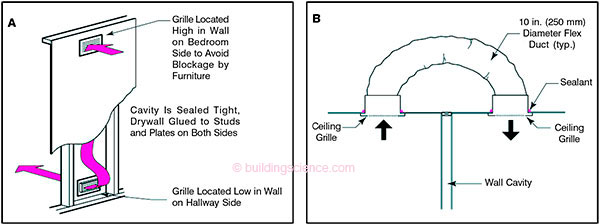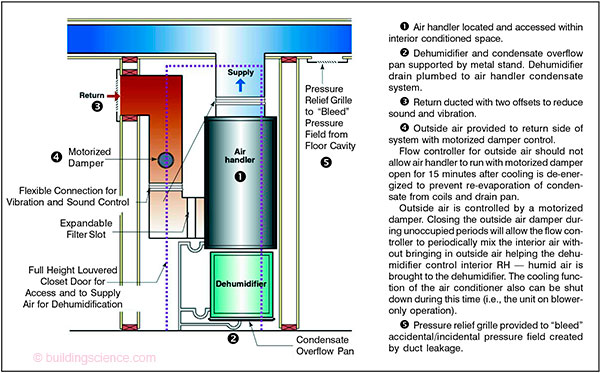Outdoor air is added to a building via a controlled ventilation system. What isn't controlled is the air change created by wind effects, stack effects and pressure effects caused by the operation of the HVAC system. The following article was published in ASHRAE Journal, April, 2002, pages 18-21. Reprinted with permission.
Adding outdoor air in hot, humid climates causes moisture problems, right? The answer is sometimes. It all depends on the condition of the house before outdoor air is added. In fact, most houses in hot, humid climates are over-ventilated due to duct leakage and induced air change from internal air pressure effects.
Outdoor air is added to a building via a controlled ventilation system. What isn't controlled is the air change created by wind effects, stack effects and pressure effects caused by the operation of the HVAC system.
In most houses, these uncontrolled effects typically are larger than the desired controlled ventilation. Adding outdoor air only makes a bad situation worse.
The desired controlled ventilation is quantified here as:
7.5 cfm/person + 0.01 cfm/ft2 of conditioned floor area
Occupancy is defined as the number of bedrooms + 1
This value comes from proposed ASHRAE Standard 62.2P, Ventilation for Acceptable Indoor Air Quality in Low-Rise Residential Buildings. The merits of this controlled ventilation rate are not discussed here. For a common single-family detached house (three bedrooms, 2,000 ft2 [186 m2]), this works out to 50 cfm (24 L/s) of outdoor air. Restated, based on typical house volumes (ceiling heights ranging between 8 ft and 10 ft [2.4 m and 3 m]), this is between 0.15 and 0.2 air changes per hour.
Wind effects and stack effects acting on residential enclosures in hot, humid climates are low.1 Most houses in hot, humid climates are one story. Therefore, only a small stack potential exists even if an appreciable temperature difference is present. The houses are often clad with stucco, which is a tight cladding system that is relatively wind insensitive.
Research done in the late 1980s and early 1990s2,3 showed that, in homes located in hot, humid climates, HVAC system operation yielded air change rates of between 0.5 and 1.0. When HVAC systems were not operating the same research showed air change rates of 0.1 to 0.2 ACH.
Duty cycles (on time) often range between 30% and 70%. Assuming a 33% duty cycle, the HVAC system induced air change is equal to a continuous ventilation rate of between 50 cfm and 100 cfm (24 and 47 L/s).
At that time, the typical house envelope leakage characteristics for new homes ranged between 2,000 and 3,000 cfm (944 and 1416 L/s) at 50 Pa. In other words, the building envelopes were fairly “leaky” for new homes, but fairly “tight” for older homes. Remember, air change does not occur without an air pressure difference — even in a “leaky” building enclosure. In the humid South, stack effects and average wind speeds acting on low-rise residential enclosures are small, which means air change due to these effects is low, and almost independent of envelope leakage area for new homes with this range of leakage characteristics.
During the past decade, residential building envelope leakage areas have decreased due to more effective draft stopping. This has resulted in an unintended consequence. Air pressure differences within houses and between houses and the exterior have increased when HVAC systems are operating. Although the airtightness of the building envelope has increased, the expected air change reduction has not occurred due to the induced air pressure effects. Houses with leaky ductwork and unbalanced airflows continue to have high air change rates despite improvements in building envelope construction.
Pressure Effects
HVAC system-induced air change occurs two ways: leaky ductwork and air handlers located outside of the building pressure boundary (Figure 1a) and unbalanced airflows due to door closure and inadequate return flow (Figure 1b). A subset of the first type of air change also occurs due to air pressure effects within building cavities (Figure 1c). This type of induced infiltration results in serious interstitial moisture problems, but does not always constitute a significant interior latent load.

Figure 1: HVAC system-induced air changes occur via: (A) leaky ductwork and AHU located outside of the building; (B) unbalanced airflows due to door closure and inadequate return flow; (C) air pressure effects within building activities.
Addressing uncontrolled HVAC system-induced air change requires tight ductwork, sealed air handlers, and balancing the flow between rooms. When these requirements are met, uncontrolled air change can be reduced to nearly zero.
Ductwork and air handler leakage can be addressed using many techniques that will not be addressed here (except to say that standard duct tape is not one of them). Leakage values of approximately 5% (as tested by pressurization at 25 Pa) of total flow or less appear to result in negligible air change when HVAC systems are operating and return system flows are balanced.6 Many federal, state and utility construction programs have promoted duct system and air handler leakage performance specifications in the 5% range. This range of duct leakage appears to be justified based on the field experience.
Pressurization effects due to door closure can cause significant air change and comfort problems. Bedroom pressurization relative to hallway/common areas of 10 to 20 Pa is common with single return systems.5,7 These effects can be mitigated using transfer grilles (Figure 2a) or jump ducts (Figure 2b).

Figure 2: Pressurization effects can be mitigated using (A) transfer grilles or (B) jump ducts.
The New Moisture Balance
If uncontrolled air change is reduced to nearly zero and replaced with a continuous flow roughly equal to the uncontrolled air change, it can be argued that the net moisture balance should remain unaffected. Adding controlled ventilation does not increase latent loads under this condition.
However, this is only true during the months when HVAC systems regularly operate. During spring and fall, the “part load” seasons, HVAC systems do not operate regularly. Air change drops to between 0.1 and 0.2 ACH. The typical house has a very low latent load due to air change during this time. This is fortunate because there is also almost no provision for moisture removal during this time by the HVAC system. Adding controlled ventilation significantly increases the latent load. In fact, the load during this time is almost completely latent because the outdoor dry-bulb temperature is very near to the indoor drybulb
temperature. This latent load is effectively doubled in the typical house by adding a ventilation rate of 0.15 and 0.2 ACH (the proposed ASHRAE Standard 62.2P rate).
Gatley4 notes that the process of air conditioning consists of approximately 70% sensible cooling in the form of temperature reduction accompanied by approximately 30% latent cooling in the form of water vapor removal. According to Gatley, at partial load operating conditions (which occur for a majority of system operating hours) many dwellings in hot, humid climates require higher ratios of latent cooling of 40% to 50%. This is not possible with standard residential airconditioning equipment.
The latent load problem under part-load conditions during spring and fall in humid climates progressively is becoming more serious as the typical residential building envelope and its mechanical equipment evolve. The use of high-performance window systems (spectrally selective windows with high visible light transmittance, low solar heat gain coefficient) is significantly increasing the time part-load conditions occur during the year. As a final insult to the house and its occupants, the equipment is typically oversized (on the order of 150% or more of total load). Adding controlled ventilation with untreated outdoor air to a house under these conditions almost ensures problems — even with tight ductwork, sealed air handlers and balanced airflows.
Gatley, citing work done by an air-conditioning system manufacturer,4 shows the effect of oversizing. Systems oversized by 20% achieve latent heat removal of approximately 15% of the total cooling load under the assumed part-load conditions. Whereas, correctly sized systems achieve moisture removal of up to approximately 30% under part-load conditions. The same work shows that correctly sized systems with variable speed fans and constant speed refrigeration compressors achieve 35% moisture removal under part-load conditions. With variable refrigeration compression, moisture removal is even greater.
Equipment sizing is not addressed here except to note that it is a major residential HVAC industry problem. Even with correctly sized standard HVAC systems, the part-load problem associated with the latent load remains, albeit not to the same extent.
The author’s experience with newly constructed houses in hot, humid climates has led to the conclusion that supplemental dehumidification during part-load periods is necessary — especially in houses with controlled ventilation. Three general approaches to supplemental dehumidification in residences are recommended: stand-alone dehumidifiers (Figure 3); enhanced air-conditioning systems (variable speed blowers and compressors); and ventilating dehumidifiers.

Figure 3: Approaches to supplemental dehumidification in residences. . .
Download complete document here.
References:
- ANSI/ASHRAE Standard 136-1993 (RA 2001), A Method of Determining Air Change Rates in Detached Dwellings.
- Cummings, J.B. and J.J. Tooley. 1988. “Infiltration rates and pressure differences in Florida homes caused by closed interior doors when the central air handler is on.” Passive Solar Conference.
- Cummings, J.B. and J.J. Tooley. 1989. “Infiltration and pressure differences induced by forced air systems in Florida residences.” ASHRAE Transactions.
- Gatley, D.P. 1993. “Energy efficient dehumidification technology.” Workshop Proceedings: Bugs, Mold & Rot II, Building Environment and Thermal Envelope Council.
- Lstiburek, J.W. 1993. “Humidity control in the humid south.” Workshop Proceedings: Bugs, Mold & Rot II, Building Environment and Thermal Envelope Council.
- Lstiburek, J.W. and A. Rudd. 2002. Controlled Ventilation in Building America Houses. Westford, Mass.: Building Science Corporation.
- Tooley, J.J. and N.A. Moyer. 1988. “Mechanical air distribution and interacting relationship.” Florida Home Energy Reviews of Orlando.
